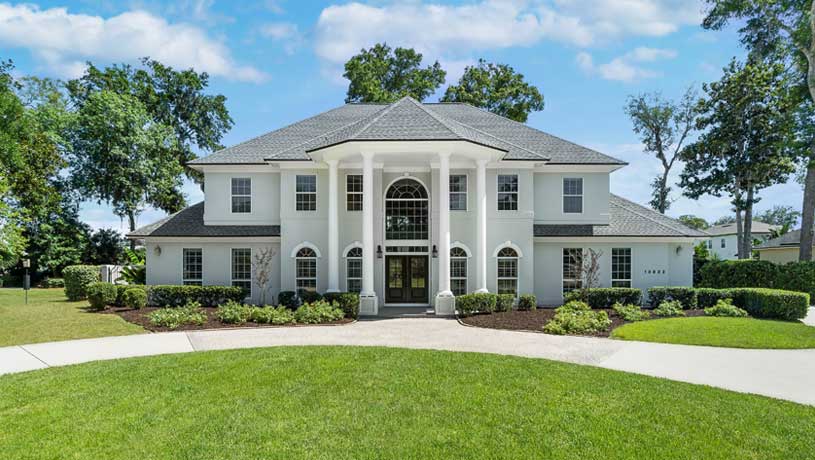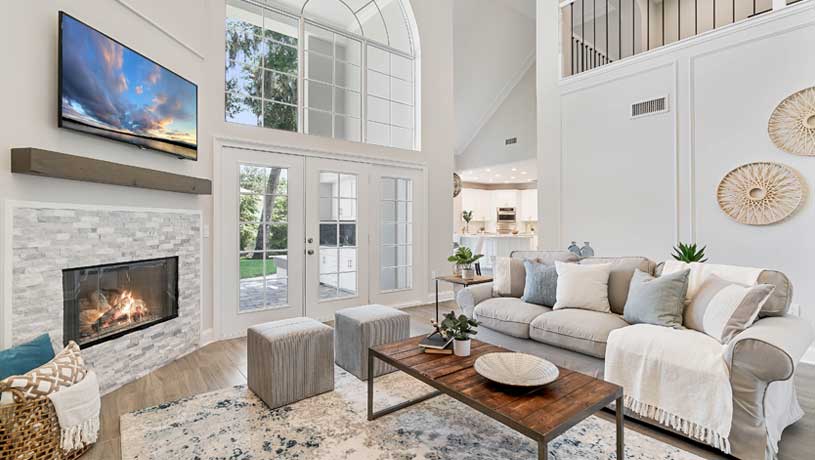How To Flip a House
Published on FEBRUARY 1, 2023 by ROB HASTINGS
CATEGORIES: Real Estate Investing | Buyer Resources
Who doesn't love a good house flip on a HGTV Show?
House flipping has become very popular in the last decade (partly due to the appeal created by shows like those on HGTV) but also because of the potential profits.
According to ATTOM, a provider of real estate data, one in every 13 homes sold in Q3 of 2022 was flipped. We even flipped a home ourselves in 2022.
The process of flipping a house involves several steps, from finding the right property to executing a successful renovation and selling the property for a profit. Let's just say it's not as easy as the TV shows make it look, and it certainly isn't completed in 30 minutes (with commercials).
This comprehensive article will guide you through the process of flipping a house and provide you with critical factors to consider.
Step 1: Research the real estate market
Before investing in a house flip, it's important to research the real estate market in the area where you plan to purchase a property. Understanding the current real estate market conditions will help you determine the feasibility of your flip and identify potential risks and opportunities. Researching the market can also help you determine the right time to purchase a property and the right time to sell it based on local market trends.
To research the real estate market, start by gathering the following information:
(1) recent sales data in the area
(2) average sale prices
(3) average days on market
(4) current inventory of available properties
This information can be obtained through websites such as Zillow, Redfin, and Realtor.com, but the best source of this information is a local real estate agent. It doesn’t cost you anything to work with an agent as a buyer, and the agent has access to the Multiple Listing Service (MLS) to do this research for you.
Another way to research the market is to look at economic indicators such as job growth, population trends, and housing prices. This information can be found on websites such as the Bureau of Labor Statistics, the U.S. Census Bureau, and the National Association of Realtors.
Step 2: Identify Properties to Flip
Once you have a good understanding of the local real estate market, it is time to start looking for properties to flip. There are several ways to find properties to flip, including:
Auction sites: Many local and online auction sites sell foreclosed homes at a discounted price. An example is Auction.com.
Local County Auctions: Foreclosures are often sold at local county auctions. In Northeast Florida, Duval, St. Johns, Nassau, and Clay Counties all hold these auctions. I personally search these auctions each week on the Duval County foreclosure website.
Real estate agents: With access to MLS and contacts in the market, real estate agents often have access to a wide range of properties and can help you find a property that meets your criteria – at no cost to you!
Direct mail campaigns: Direct mail campaigns allow you to target homeowners who may be interested in selling their homes. You can design these direct mailers on sites like Canva or have a designer do it for you cheaply on Fiverr.com. You can then use a site like VistaPrint to print and mail the mailers for you.
Online real estate listings: Websites such as Zillow and Redfin offer a wide range of real estate listings, including foreclosures, short sales, and homes for sale by owner. Look for homes with bad pictures as these homes are usually getting less views (and also less competition). Use these websites in conjunction with the other sources.
Drive Around: Drive around areas that your market research has identified as a possibility and look for signs of neglect or disrepair such as boarded up windows, overgrown lawns, or peeling paint. These are signs of a distressed property. Find the owner’s contact information or send the owner a letter. I use a website called Spokeo to find owners' information.
Step 3: Evaluate the Property and Potential Profitability
Once you have identified a property that you are interested in flipping, thoroughly evaluate it before making an offer. This will help you to determine the potential profits and any potential problems that may arise during the flipping process.
The first step in evaluating a property is to consider the condition of the property and any repairs that may be necessary. Condition is more than cosmetics. Be sure to consider major components and systems such as the roof, HVAC, plumbing, and electrical which are expensive, especially when buying a older home. If in need of replacement, these items can overwhelm your profits and add time to your flip. If this evaluation is outside of your skillset, consider hiring a professional home inspector.
Next, you should consider the potential costs of renovations and repairs. You can use online renovation cost calculators or consult with a contractor to get a rough estimate of the costs involved.
You should also get a detailed understanding of the amount of time that it will take to complete the renovations. Time is an often-overlooked component of a house flip. Operating and holding costs only increase the longer it takes to flip the home.

This is the house we flipped in 2022. We estimated a renovation budget of approximately $100,000, and the final improvement cost was $102,320.24, slightly over our budget.
Finally, analyzing the potential profitability of a flip involves understanding the 70% rule, which states that the maximum amount you should pay for a property is 70% of its after-repair value minus the estimated cost of repairs.
Step 4: Create a renovation plan
Once you've found a property and evaluated its potential profitability, the next step is to create a renovation plan.
The renovation plan should include a detailed budget, a timeline, and a list of the work that needs to be done to bring the property up to market standards. You'll need to consider the cost of materials, labor, permits, and other expenses, as well as any unexpected costs that may arise during the renovation process.
Step 5: Obtain financing
Once you have a renovation plan in place, the next step is to obtain financing for the flip. There are several options for financing a house flipping project, including traditional loans from banks, hard money loans from private lenders, and personal savings.
The type of financing you choose will depend on several factors, including your credit score, the amount of money you need to borrow, and the length of time you plan to hold the property.
If you have good credit and a substantial amount of savings, you may be able to secure a traditional loan from a bank. Typically, banks require a higher downpayment amount for an investment property (usually a 25-30% downpayment). If you have a lower credit score or need a quick infusion of cash, you may need to consider a hard money loan.
Step 6: Make an Offer
Once you have thoroughly evaluated the property and obtained financing, it is time to make an offer. When making an offer, it is important to consider the following factors:
Purchase Price: As discussed previously, your offer price should consider the 70% rule, which states that the maximum amount you should pay for a property is 70% of its after-repair value minus the estimated cost of repairs.
Closing Costs: Closing costs can add up quickly – both when purchasing the property and when selling it. Be sure to account for these costs when evaluating a property's potential profit and when making your offer.
Typically, in Northeast Florida, investors can count on 2.5 to 3 percent of the purchase price as the amount needed for closing costs when purchasing an investment property using financing. On a cash purchase, the amount of closing costs is much less as most closing costs on a purchase are related to costs of the loan.
When selling, closing costs are typically 5.5 to 8 percent of the sales price. These costs (approximately 1.5 percent) include deed stamps (transfer taxes), owner’s title insurance, and prorated property taxes, among other costs, but the largest component is real estate commissions (4 to 6 percent).
Make sure to factor these costs into your initial offer.
Step 7: Execute the Renovation
While the television shows make house renovations look easy, the truth is that a full home renovation isn’t for the faint of heart.
When executing your renovation plan, it is important that you follow your plan as close as possible. This includes having a trusted team of contractors and sub-contractors in place to do the work, who show up on time, and do good work.
Decide on your personal involvement in the renovation:
-Will you stay at arms-length and allow contractors to coordinate and do the renovation?
-Will you act as a GC and coordinate contractors?
-Will you do some of the work yourself?
The more you do yourself, the better your profitability. Leverage your skills but don’t do so at the expense of time. The speed of executing your renovation is paramount.
Step 8: Stage the Property
Staging a home for sale is an essential step for investors who have completed a house renovation and are looking to maximize their returns. This process enhances the appeal of the home to potential buyers, creating a space that feels both inviting and functional.

We brought in our professional stager to stage this flip we did. The staging adds color, warmth, and class to the blank space and neutral walls, giving buyers a vision for the home.
Studies have shown that homes that are staged before listing can sell faster and for higher prices than those that are not as buyers are able to more easily visualize themselves living in the space. Additionally, well-staged homes are often seen as more desirable and well-maintained, leading to increased competition among potential buyers.
Also, while interior staging is certainly important, don't forget about the outside. Curb appeal is the first impression buyers will have when arriving for a showing at your flip.
Step 9: Market and Sell the Property
Once the renovations are complete, it's time to market and sell the property. You can do this by listing it for sale by owner or working with a real estate agent.
Market the property with excellent listing photos and video. Showcase the renovations you have completed. Use open houses to get as many people to see the property as possible. The goal is to create a sense of urgency so that potential buyers are more likely to make an offer.
Bottom Line
In conclusion, flipping a house can be very profitable, but it's not without its challenges. You need to have a good understanding of the market, the right skills and resources, and a solid plan for how to make the investment work. If you're willing to put in the time and effort, however, you can achieve great success in flipping houses.
Related Articles:
Best Areas in Northeast Florida to Invest in Real Estate
ABOUT THE AUTHOR:

Rob Hastings is a top-producing real estate agent in Jacksonville, Florida and helps buyers, sellers, and investors of homes and property throughout all of Northeast Florida. He works with his wife Nancy as a husband-and wife-team with Keller Williams Realty Atlantic Partners. When not helping his clients navigate the real estate process, Rob enjoys working on old Corvettes and playing music (guitar and piano). A U.S. Naval Academy graduate and former Naval Officer, he also loves boating and simply spending time on the water.
